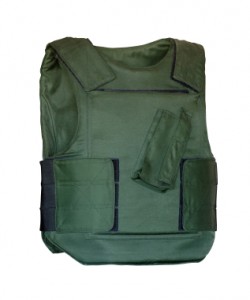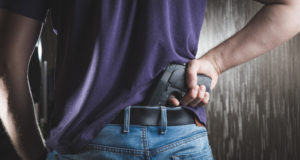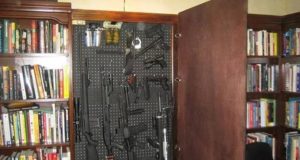Body armor should be a primary consideration for any truly serious prepper or retreat homeowner. Whatever your word du jour is to describe either a prepper, survivalist, or off-grid homeowner, most of them are more concerned with how many guns to buy, what kind of guns to buy, and building up mountains of food in #10 cans. This is all fine and good, and it should be thought of and planned for, no doubt. What if, however, the first time you’re met with any serious resistance, you take a bullet? What if it’s the first bullet of the engagement, and moreover, it is a fatal hit? Your preps are for naught in that case.
Body armor has a certain stigma around it, mainly held by civilians who feel that purchasing or using body armor firmly puts them into the “Rambo” side of things might cause them to be viewed as extremists. To compound this, there are extremely vague laws in most states as to the legality of body armor (as of this writing, it’s legal most anywhere in the U.S. except in the commission of a crime or in the possession of felons). Most law enforcement officers also take a dim view of civilians owning body armor and are frequently the source of most body armor disinformation. As a prepper however, especially in a situation where there might be civil unrest, body armor is an important consideration. Although it can be relatively expensive, it should be looked into.
 Types of Body Armor
Types of Body Armor
Most people equate body armor with “bulletproof vest.” First of all, no armor is completely bulletproof, and second, a vest is not the only form of body armor. Body armor is loosely categorized by the National Institute for Justice into various levels of protection, called types. These types are categorized by bullet weights and muzzle velocities they are more or less resistant for. To break it down simply:
- Type I: .22LR, .380 ACP
- Type IIA: 9mm, .40 S&W, .45 ACP
- Type II: 9mm, .357 Magnum
- Type IIIA: .357 SIG, .44 Magnum
- Type III: 7.62 x 51 NATO (.308)
- Type IV: Various kinds of armor-piercing rifle rounds
Practically speaking, Level IIIA and under are soft armor (i.e. Kevlar based vests) and Level III and IV are hard armor, such as plates. Another interesting delineation is that soft armor ceases to be concealable above Level IIA – in fact, most police officers in the United States actively wear Level IIA armor under their shirts on a daily basis. This armor is good for common pistol calibers, and while you can tell the officer is wearing a vest, it is not overly bulky.
Level IIIA armor is mainly used in the construction of over-the-shirt vests or exposed armor. This type of armor is the typical armor that SWAT teams will wear as well as certain police officers who carry emergency armor in their trunk in case of a major altercation. Many of these vests have the capability to accept hard plates, such as the Level IV plates. They use pockets sewn into the vest that accept the plates—usually one on the chest and one on the back, but they sometimes can accept side plates as well.
The military uses exclusively Level IIIA and Level IV armor in combination, although military ratings do not directly coincide with civilian NIJ ratings. Military armor also is designed to prevent against fragmentation as well.
What This Means to You as a Prepper
In theory, you wear the armor for the highest possible threat you will encounter. In practice, you wear what’s comfortable and what you will wear often, because even some armor is better than no armor. What’s interesting is that the bulk of civilian police officers do not have armor that protects them against any sort of rifle round. The Level IIA armor worn by most cops is easily penetrated by .223, .308, 7.62 x 39, or any sort of popular hunting cartridge in America, and yet, they keep wearing it. This directly illustrates how America is very much a pistol-based threat society.
At a minimum, the vest you purchase should have the ability to accept hard plates, and that usually means purchasing exposed armor. Exposed armor like military IBA and IOTV vests (and clones) as well as plate-carrier-type systems have some serious advantages for the wearer. For starters, they are usually designed to by much tougher externally and use fabrics on the outside like 1000 denier nylon – ultra strong. They also accept hard plates for the front and back, and some models accept side plates. These vests and plate carriers are also usually equipped with MOLLE loops so you can add ammunition and sustainment pouches to the vest, giving you a full load out at your fingertips. Accessories are also widely available— things that take protection to the next level such as collar yokes and groin protectors and clever features like pull releases to drop the armor in the event of an emergency.
The Downside
With all good things come a slew of negatives, and armor has many, many disadvantages. The first and foremost is cost. Armor is no place to save a buck (it’s your body after all, right?), and manufacturers realize that. Plan on spending a minimum of $350-700 per vest on a military-grade Level IIIA system (without pouches) and at least another $600 on hard plates. Plan for more if you want ceramics and more yet if you want side plates. And all this is per person. Think of it this way though: A set of armor, properly cared for, will last a long time, and there is always a market for expired armor as well.
Weight represents a substantial factor as well. Expect a military-grade IIIA system with plates to weigh in at between thirty and forty pounds, and much more in larger sizes and with equipment added on. Armor is not something you buy and stuff in a closet, never to see it again. You need to train with it and adapt to the weight of it and the limited range of motion that it penalizes you with. It’s amazing what you can do after your body adapts to the load –soldiers routinely march for miles and operate in all sorts of conditions without really noticing the weight anymore, as they are conditioned to the weight.
Lastly, heat is something to think about with armor. More coverage means less air circulation, which means more heat buildup. Compound that with the weight, and you may soon find yourself tired and dehydrated – if you haven’t adapted to your new armor.
Body armor isn’t just for cops and soldiers – body armor is for any law-abiding and responsible person who wants a level of threat protection should a situation go south fast. It should be a part of every survival retreat and factored into your plans.
©2012 Off the Grid News
 Off The Grid News Better Ideas For Off The Grid Living
Off The Grid News Better Ideas For Off The Grid Living



